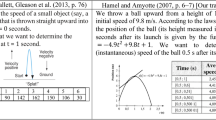
Overview
- Designed to introduce the reader to hypernumbers and extrafunctions, which is another rigorous mathematical approach to operations with infinite values
- Shows that even in the most standard case of real analysis, hypernumbers and extrafunctions significantly extend the scope and increase the power not only of the classical calculus but of its moderngeneralizations and extensions, such as distribution theory or gauge integration
- Used for enhancing traditional courses of calculus for undergraduates, as well as for teaching a separate course for graduate students
Part of the book series: SpringerBriefs in Mathematics (BRIEFSMATH)
Access this book
Tax calculation will be finalised at checkout
Other ways to access
About this book
“Hypernumbers and Extrafunctions” presents a rigorous mathematical approach to operate with infinite values. First, concepts of real and complex numbers are expanded to include a new universe of numbers called hypernumbers which includes infinite quantities. This brief extends classical calculus based on real functions by introducing extrafunctions, which generalize not only the concept of a conventional function but also the concept of a distribution. Extrafucntions have been also efficiently used for a rigorous mathematical definition of the Feynman path integral, as well as for solving some problems in probability theory, which is also important for contemporary physics.
This book introduces a new theory that includes the theory of distributions as a subtheory, providing more powerful tools for mathematics and its applications. Specifically, it makes it possible to solve PDE for which it is proved that they do not have solutions in distributions. Also illustrated in this text is how this new theory allows the differentiation and integration of any real function. This text can be used for enhancing traditional courses of calculus for undergraduates, as well as for teaching a separate course for graduate students.
Similar content being viewed by others
Keywords
Table of contents (6 chapters)
Reviews
From the reviews:
“Burgin (UCLA) provides an introduction to the theory of hypernumbers in this short book, part of the ‘SpringerBriefs in Mathematics’ series. The (real) hypernumbers are an extension of the real numbers that permits operations with infinite quantities; a real general extrafunction is a partial map from the set of real hypernumbers to itself. … Summing Up: Recommended. Advanced upper-division undergraduates, graduate students, and researchers/faculty.” (D. Robbins, Choice, Vol. 50 (3), November, 2012)Authors and Affiliations
Accessibility Information
Bibliographic Information
Book Title: Hypernumbers and Extrafunctions
Book Subtitle: Extending the Classical Calculus
Authors: Mark Burgin
Series Title: SpringerBriefs in Mathematics
DOI: https://doi.org/10.1007/978-1-4419-9875-0
Publisher: Springer New York, NY
eBook Packages: Mathematics and Statistics, Mathematics and Statistics (R0)
Copyright Information: Mark Burgin 2012
Softcover ISBN: 978-1-4419-9874-3Published: 17 May 2012
eBook ISBN: 978-1-4419-9875-0Published: 16 May 2012
Series ISSN: 2191-8198
Series E-ISSN: 2191-8201
Edition Number: 1
Number of Pages: VII, 160
Topics: Analysis, Functional Analysis, Partial Differential Equations, Measure and Integration, Mathematical Methods in Physics



